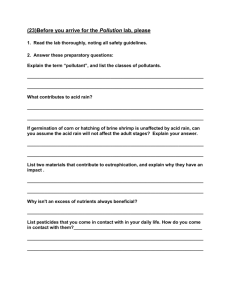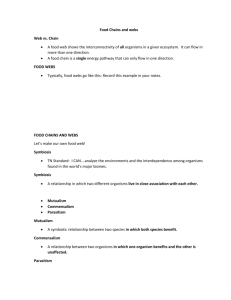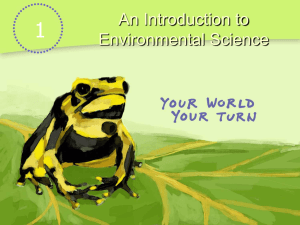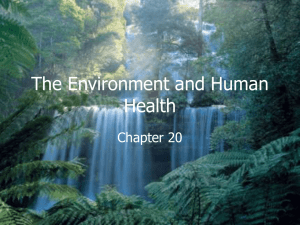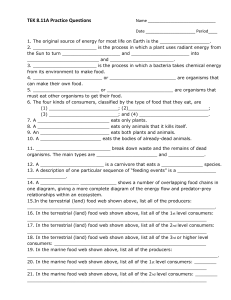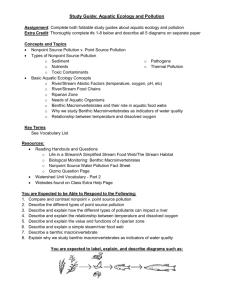Name: Date: Period: Chapter 2 Review Sheet (Hydrosphere Pt. 2
advertisement
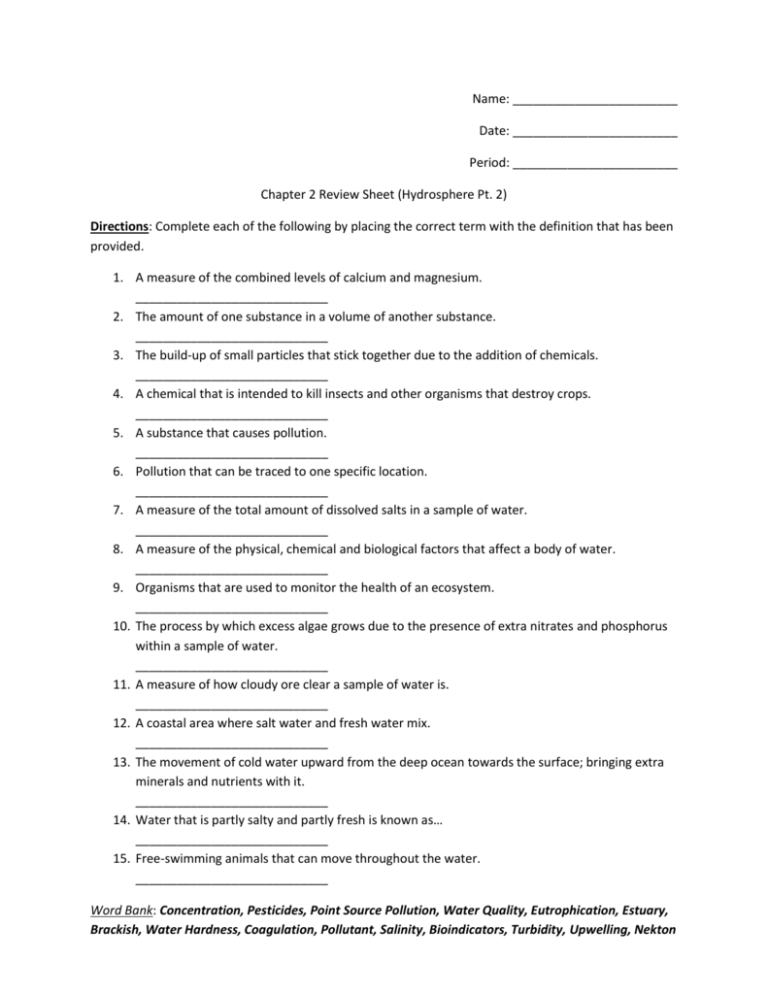
Name: ________________________ Date: ________________________ Period: ________________________ Chapter 2 Review Sheet (Hydrosphere Pt. 2) Directions: Complete each of the following by placing the correct term with the definition that has been provided. 1. A measure of the combined levels of calcium and magnesium. ____________________________ 2. The amount of one substance in a volume of another substance. ____________________________ 3. The build-up of small particles that stick together due to the addition of chemicals. ____________________________ 4. A chemical that is intended to kill insects and other organisms that destroy crops. ____________________________ 5. A substance that causes pollution. ____________________________ 6. Pollution that can be traced to one specific location. ____________________________ 7. A measure of the total amount of dissolved salts in a sample of water. ____________________________ 8. A measure of the physical, chemical and biological factors that affect a body of water. ____________________________ 9. Organisms that are used to monitor the health of an ecosystem. ____________________________ 10. The process by which excess algae grows due to the presence of extra nitrates and phosphorus within a sample of water. ____________________________ 11. A measure of how cloudy ore clear a sample of water is. ____________________________ 12. A coastal area where salt water and fresh water mix. ____________________________ 13. The movement of cold water upward from the deep ocean towards the surface; bringing extra minerals and nutrients with it. ____________________________ 14. Water that is partly salty and partly fresh is known as… ____________________________ 15. Free-swimming animals that can move throughout the water. ____________________________ Word Bank: Concentration, Pesticides, Point Source Pollution, Water Quality, Eutrophication, Estuary, Brackish, Water Hardness, Coagulation, Pollutant, Salinity, Bioindicators, Turbidity, Upwelling, Nekton Multiple Choice: Place the correct answer on the line that has been provided to you for each multiple choice question. (1/2 pt. deduction for not following directions on each question) 16. _____ Which of the following is a map that shows the surface features of an area, such as elevation changes? a. SONAR b. Topographic Maps c. Satellite Images 17. _____What is pollution that can accumulate from species to species, moving up the food chain until it eventually affects the whole food web? a. Toxic Waste b. Bioaccumulation c. Non-Point Source Pollution 18. _____Which of the following is not an example of an Abiotic Factor? a. Grass b. Temperature c. Water 19. _____All Primary Consumers are __________________. a. Autotrophs b. Omnivores c. Herbivores 20. _____Coral Reefs are found in… a. Warm and Deep Benthic Areas b. Warm and Shallow Benthic Areas c. Cold and Shallow Intertidal Areas 21. _____Which of the following is an example of an autotroph? a. Primary Energy Source b. Secondary Consumer c. Primary Producer True or False: If the statement is true, write true. If the statement is false, write false 22. _________________ Anoxia occurs when water contains low levels of oxygen; between 24 ppm. 23. _________________ The pH scale is used to measure how acidic or basic a solution is. 24. _________________ Symbiotic Relationships, also known as Symbiosis, shows the feeding relationships between two organisms. 25. _________________ Terrestrial food webs show the relationships between oceanic organisms. 26. _________________ Water that moves over Earth’s surface instead of soaking into the soil is called sewage. Food Webs/Food Chains: Use the diagram to answer the following questions. 27. 28. 29. 30. Which organism would be an autotroph? _________________________ Name an example of a Secondary Consumer. ______________________ What is an example of a decomposer? ___________________________ Name a symbiotic relationship that connects the aquatic and terrestrial food webs. ___________________________________________________ 31. What is a “top predator?” Name an example within the food web. _____________________________________________________________________________ 32. Create an example of a food chain using the food web above. 33. What is the Primary Energy Source of this food web? __________________________________ Topographic Maps: Use the following topographic map to answer the questions that are related. Elevation is measure in feet. 34. What is the elevation at the following points? A. ____________ B. ________________ C. __________________ D. ________________ 35. What is the contour interval of this map? _____________________________ 36. What direction does Long Creek flow? _______________________________ 37. What is the approximate distance from Point A to Point B? ______________________
